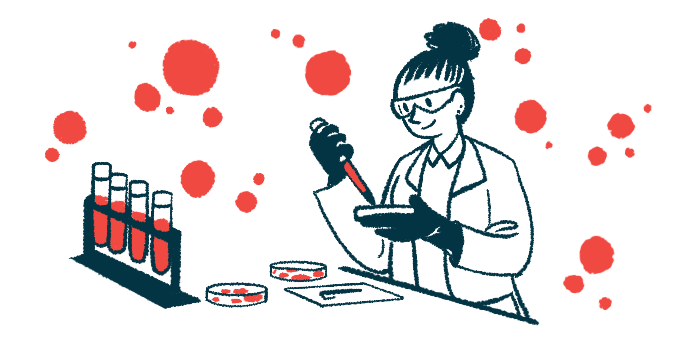Exportin-1 function may explain blood cancer treatment side effects
Scientists discover that protein helps regulate widespread gene activity
Written by |

Exportin-1, a therapeutic target for nuclear export inhibitors — a class of drugs used to treat blood cancers including multiple myeloma and leukemia — also helps regulate widespread gene activity, a study revealed.
This newly discovered function may explain the toxicities related to these therapies, suggesting that targeting exportin-1 to modulate the activity of certain genes, instead of nuclear export, may be a safer treatment strategy, according to the researchers.
“Inhibitors of exportin-1 are given to patients who fail to respond to first- or second-line chemotherapies,” Tiffany Ge, the study’s first author and a doctoral candidate at Northwestern University’s Feinberg School of Medicine, said in a university news story. “But these therapies are very toxic and have many side effects because they block all nuclear export, which is an essential function of cells.”
The findings of this work shed new light on the processes underlying blood cancers. According to the university, this “unexpected finding could help scientists better understand how cancer grows — and how to fight it.”
The study, “Exportin-1 functions as an adaptor for transcription factor-mediated docking of chromatin at the nuclear pore complex,” was published in the journal Molecular Cell.
Northwestern scientists investigate role of exportin-1 in blood cancer
Exportin-1, also called Xpo1 or Crm1, is a protein that orchestrates the shuttling of proteins out of the nucleus, where the cell’s genetic information is stored.
One way cancer cells grow is to exploit exportin-1’s function to export tumor suppressor proteins — ones that block cancer-promoting mechanisms — out of the nucleus. In fact, cancer cells often produce excessive amounts of exportin-1 to ensure these proteins don’t interfere with their growth.
Because of its role in cancer, exportin-1 inhibitors have been developed to keep more tumor suppressors inside the nucleus and halt cell division, thereby inhibiting tumor growth.
One such therapy is selinexor, sold under the brand name Xpovio, among others, for treating multiple myeloma, a type of blood cancer. It’s also being investigated for other cancers, like leukemia. Still, selinexor’s prescribing information warns about serious side effects, including toxicities related to the gastrointestinal tract and nervous system, as well as lowering platelet and immune neutrophil counts.
Nuclear export, as well as import, is mediated by protein channels, called nuclear pore complexes, or NPCs, that are found within the membrane of the nucleus. Some of these ring-like channels, composed of about 30 different pore proteins called nucleoporins, or Nups, are thought to interact with sites on chromosomes and help regulate gene expression, or transcription.
A team led by Jason Brickner, PhD, a professor of biochemistry and molecular genetics at Northwestern, used yeast as a model organism to investigate the underlying mechanism linking NPCs and chromosomes because its nucleus shares many features with those of plants, animals, and fungi.
Unexpectedly, the team discovered that exportin-1 serves as an adaptor between transcription factors, or proteins that bind directly to DNA and control gene activity, and Nups to mediate the interaction between NPCs and chromosomes.
According to the team, “this function is distinct from [its] role as a nuclear export factor.”
The researchers showed that the protein interacted with Gcn4, a transcription factor and a “master regulator” of gene expression in yeast. Gcn4 mutations weakened this interaction and generally disrupted the localization of Gcn4 target genes to the outer edge of the inner nucleus.
New findings provide ‘molecular explanation’ for researcher’s old discovery
Conversely, blocking the action of the protein rapidly disrupted the localization of both Gcn4-dependent and Gcn4-independent genes. The interaction between exportin-1 and Gcn4 was independent of nuclear export functions, the team noted.
Single-molecule tracking of exportin-1 suggested that about 12% of the protein was bound to chromosomes. In particular, exportin-1, along with the Nup proteins, Nup1, Nup2, and Nup60, bound upstream of hundreds of highly active genes.
Further experiments demonstrated that exportin-1 and Nup2 promoted enhanced gene activity. At the same time, reducing the function of both of these two proteins resulted in a substantial decrease in the activity of hundreds of genes. Exportin-1 inhibition also blocked the interaction of Nup2 with the genome, or the complete set of instructions in a living organism, made up of DNA, that tells the body how to grow, function, and develop.
Within yeast cells, exportin-1 was found to stably interact with the NPC, particularly the portion of the pore facing inside the nucleus. In test tubes, researchers confirmed that the protein bound directly to both Gcn4 and Nup2.
This work also raises the possibility that this newly discovered function is important in promoting cancer growth.
“We propose that [exportin-1] serves as an adaptor between [transcription factors] and nuclear pore proteins to mediate [chromosome]-NPC interactions and promote transcription,” the researchers wrote. “Future work will test if [the protein] serves as an adaptor for other [transcription factors] in yeast and other organisms. … It seems plausible that [exportin-1] has a similar role in mammals.”
Brickner, the study lead, noted that “the work provides a molecular explanation for a phenomenon I discovered 20 years ago — the movement of genes to the nuclear periphery when they are turned on.”
Given that exportin-1 is “often overexpressed in cancers and leukemia,” Brickner said “this work also raises the possibility that this newly discovered function is important in promoting cancer growth.”








